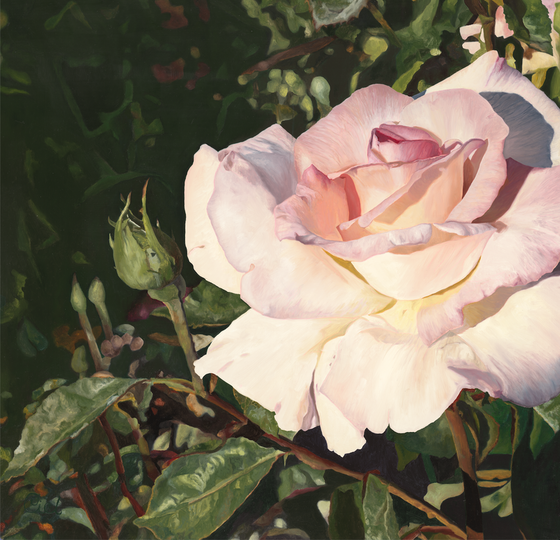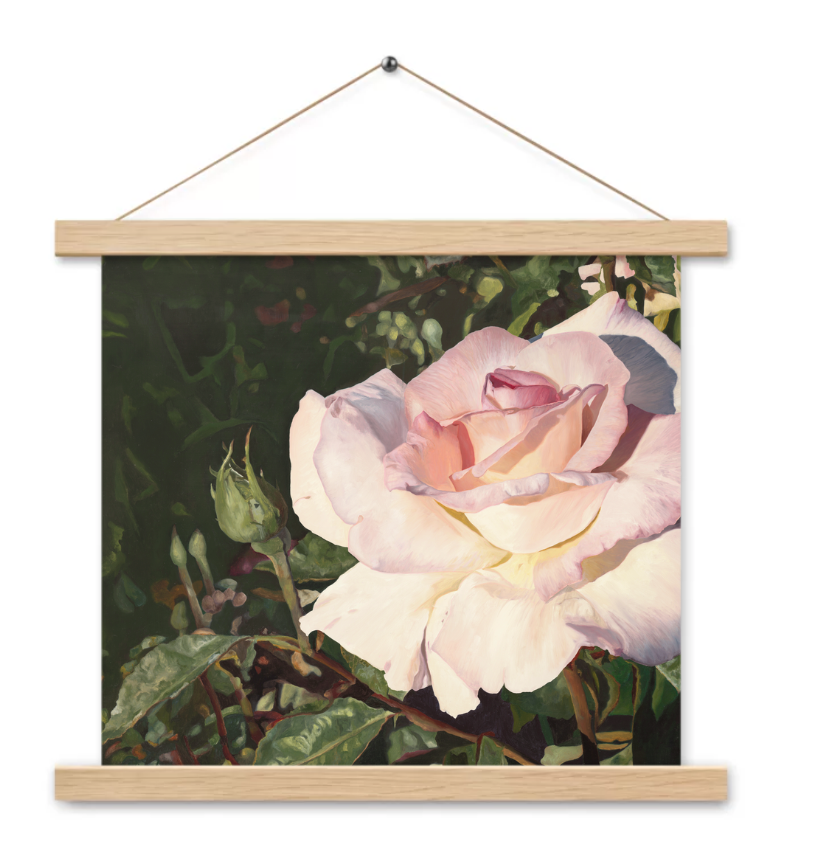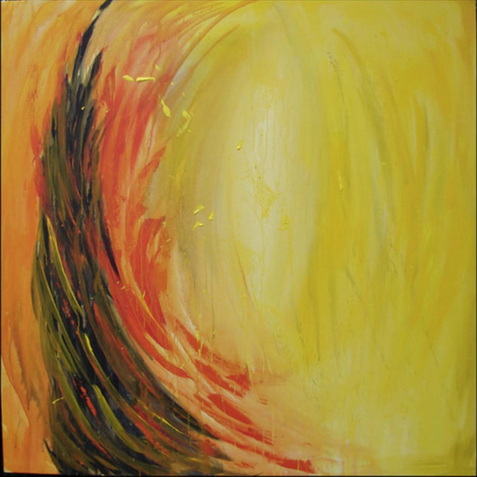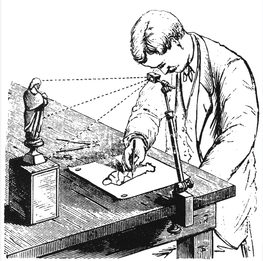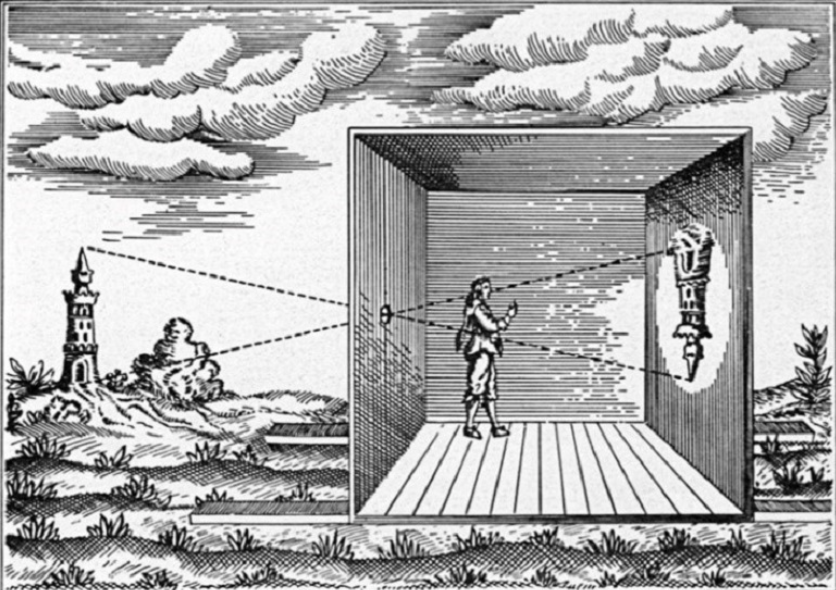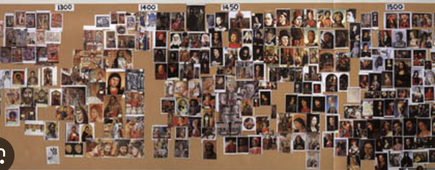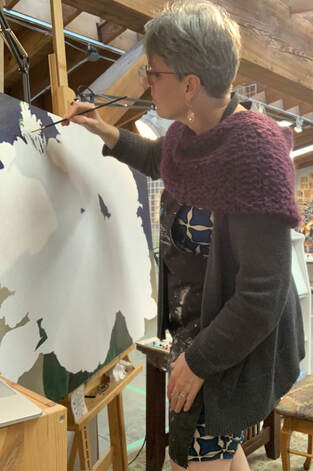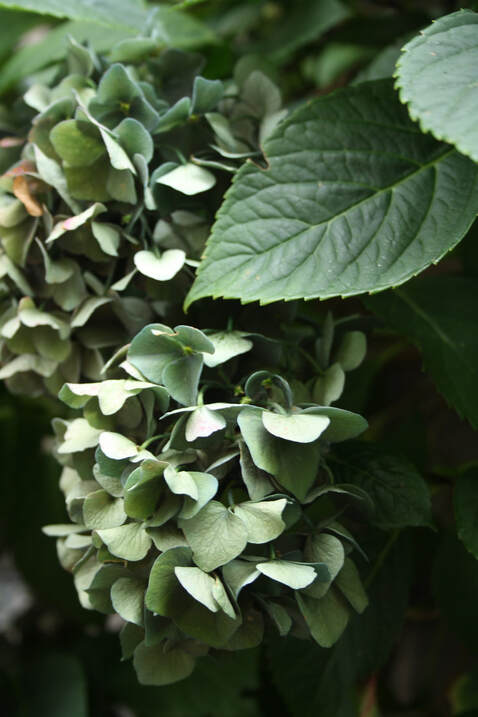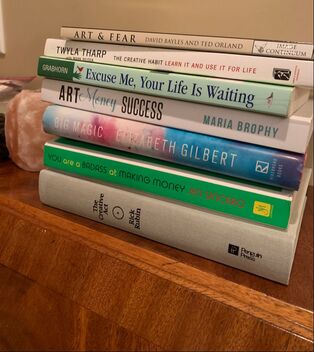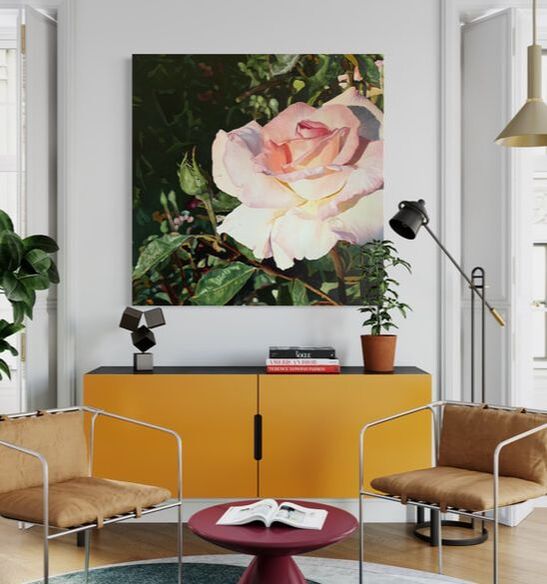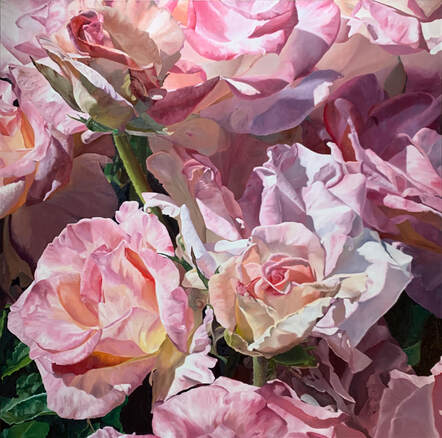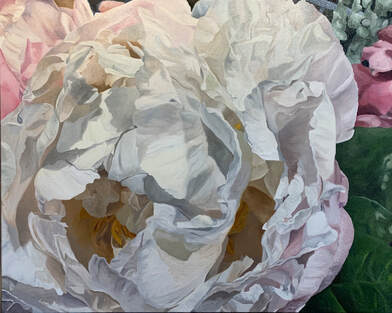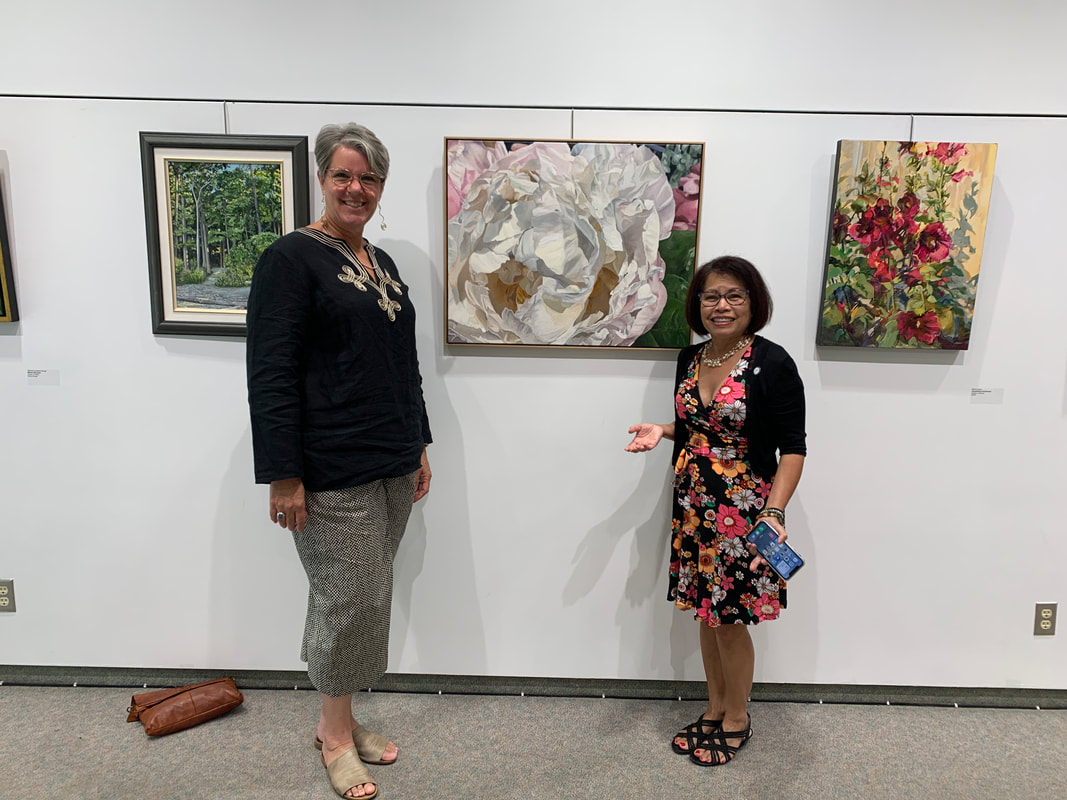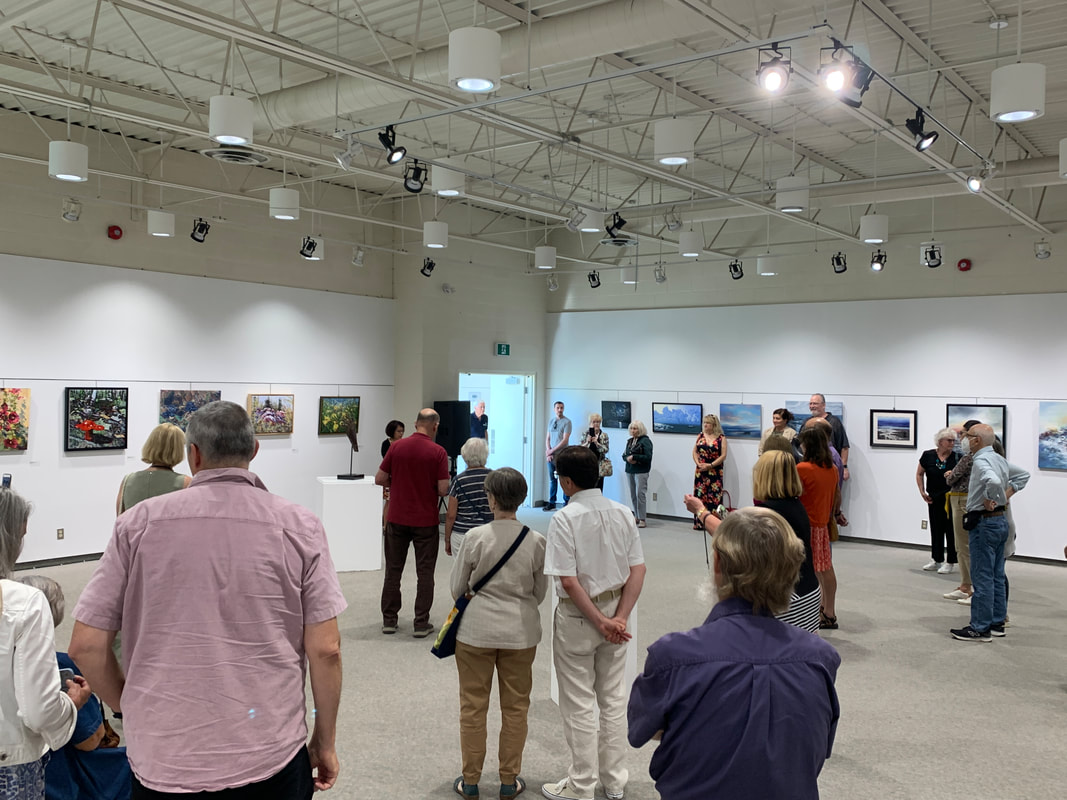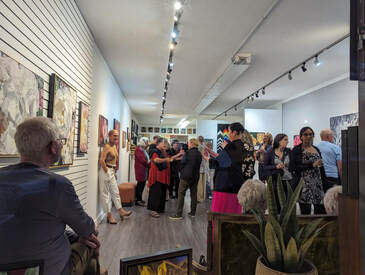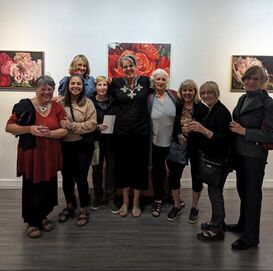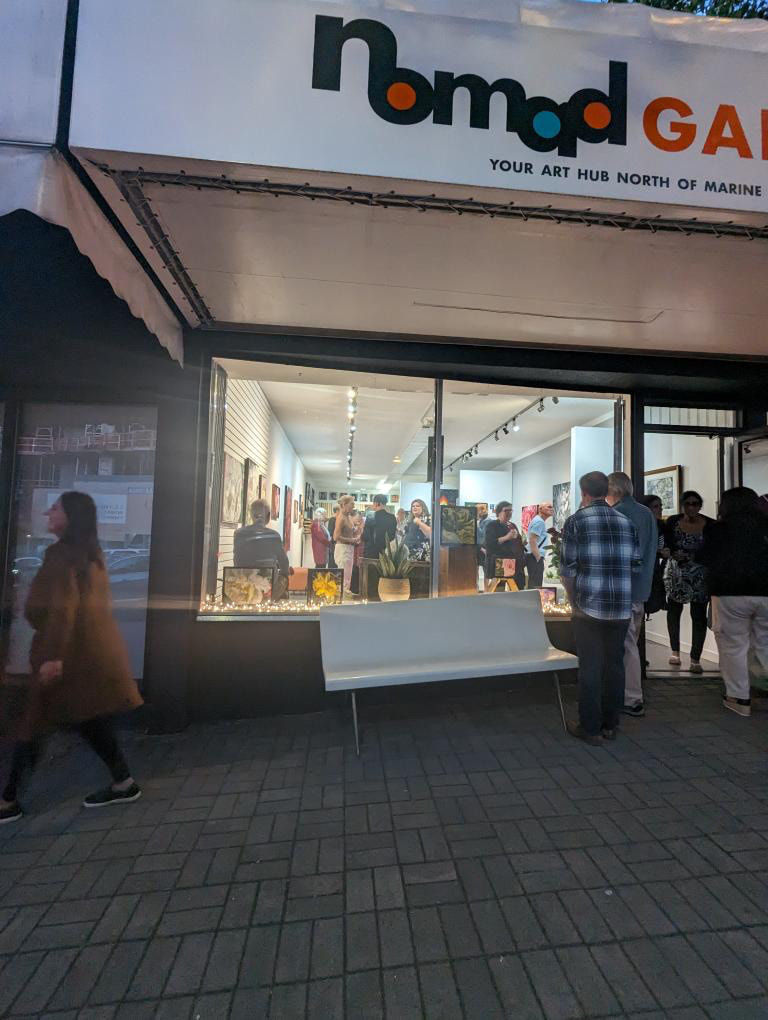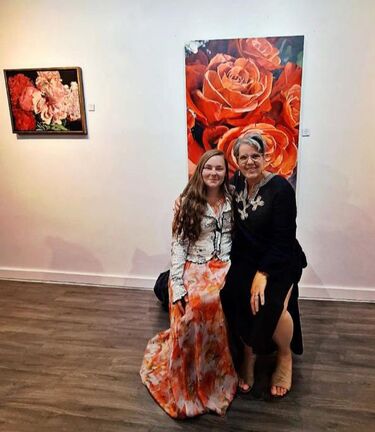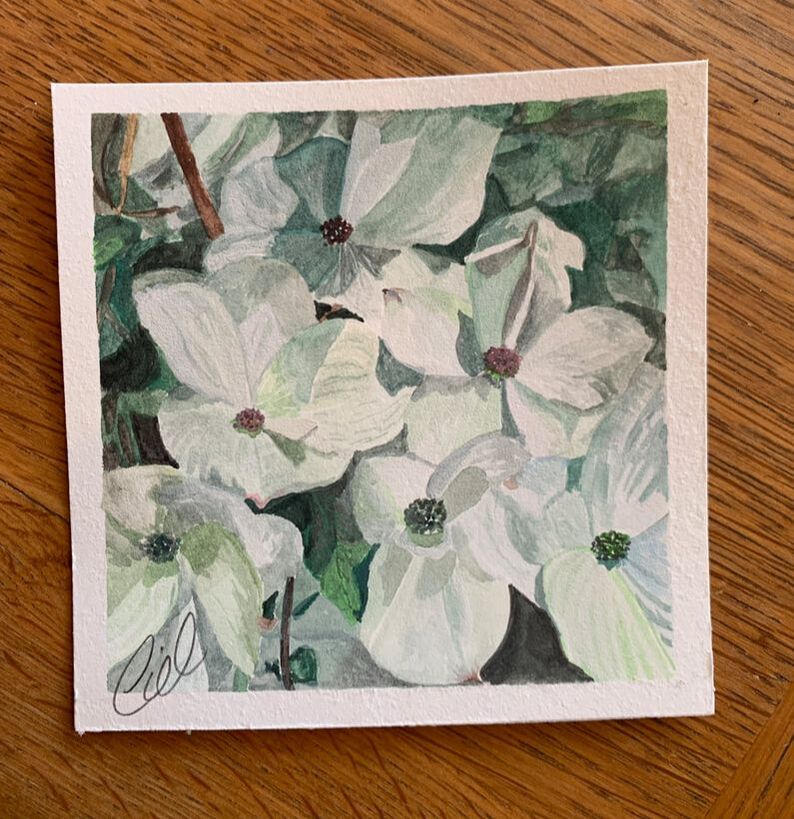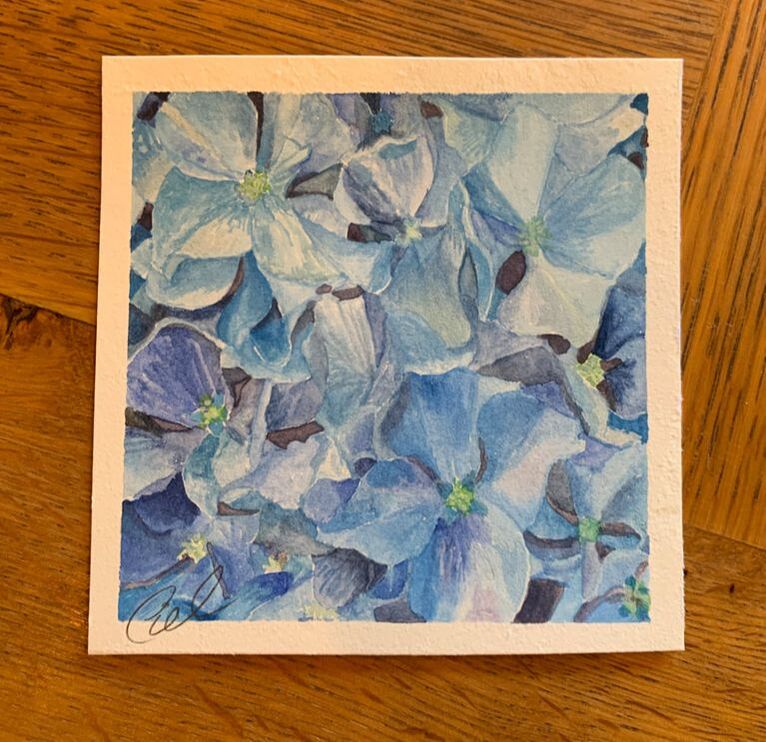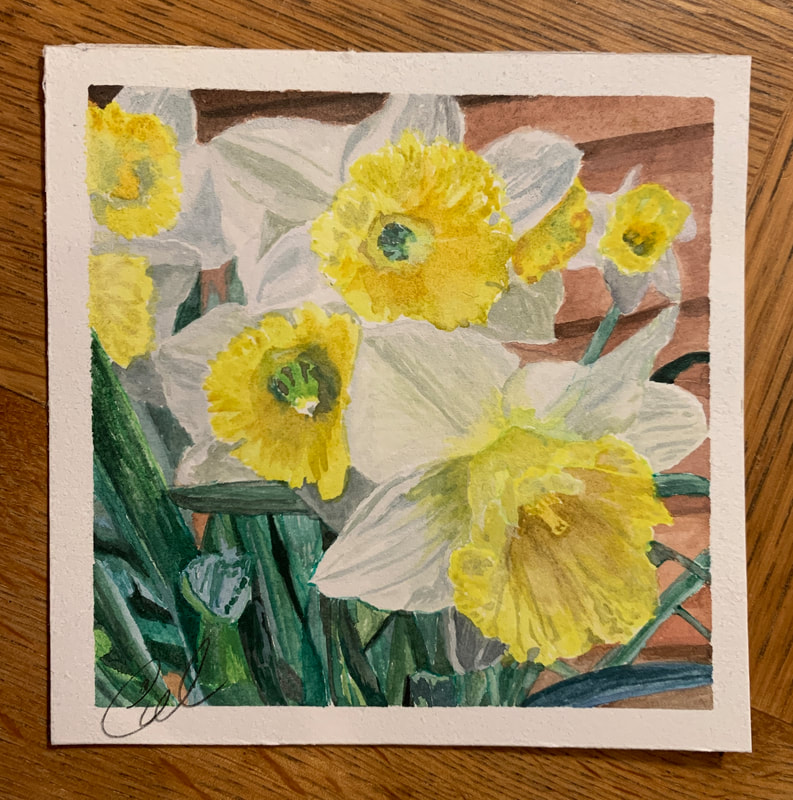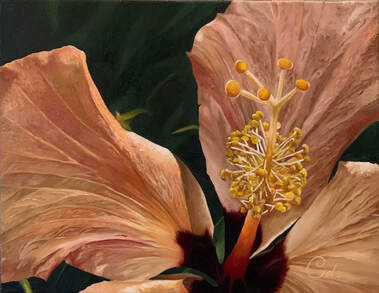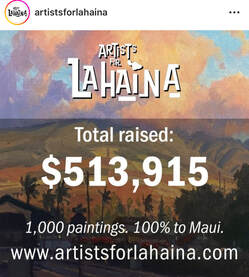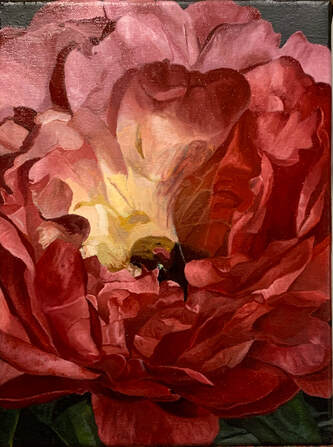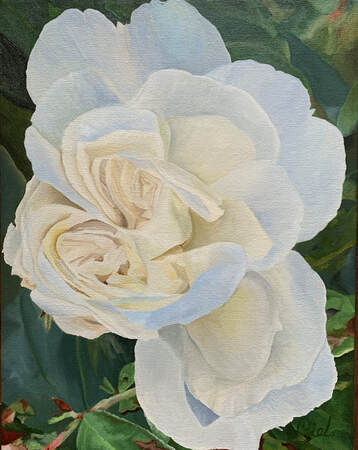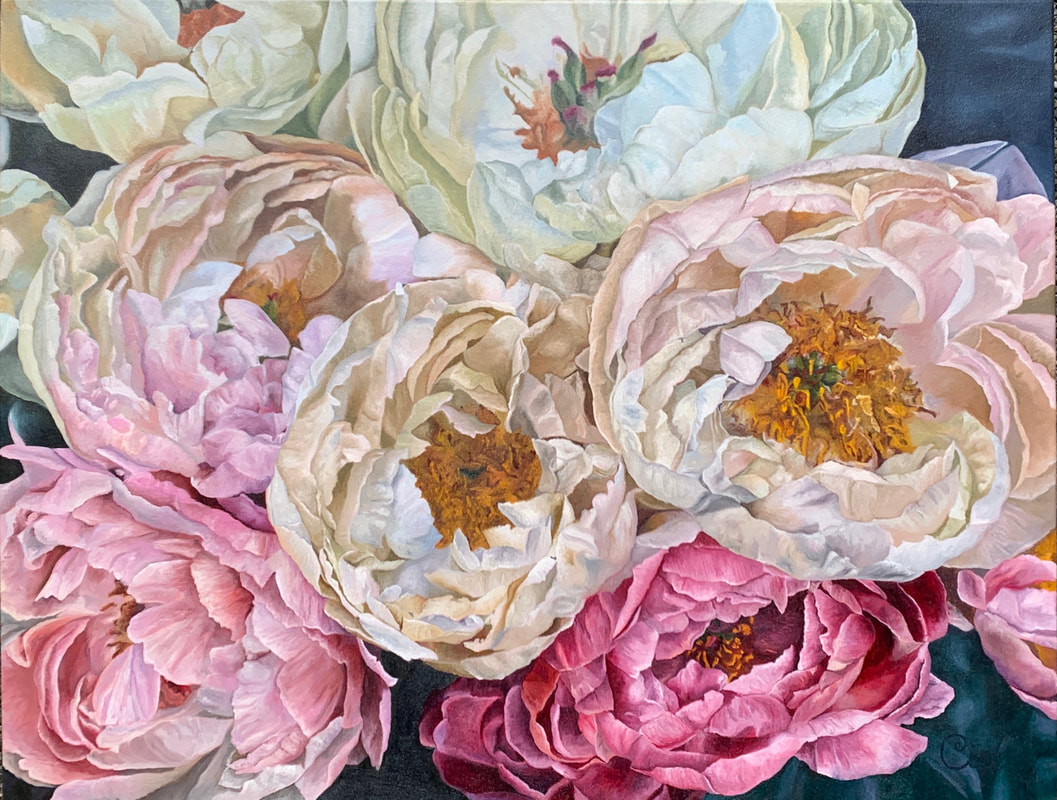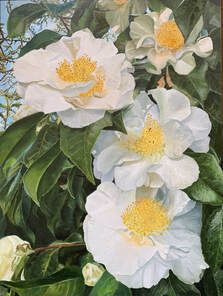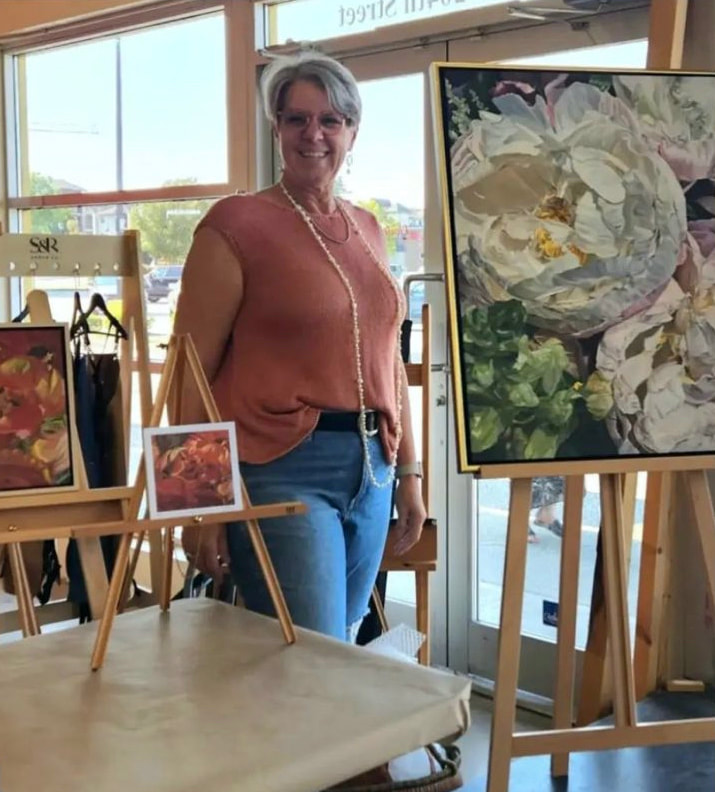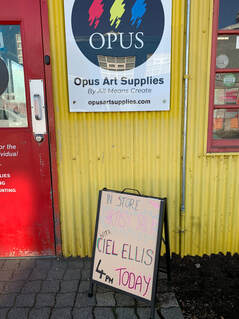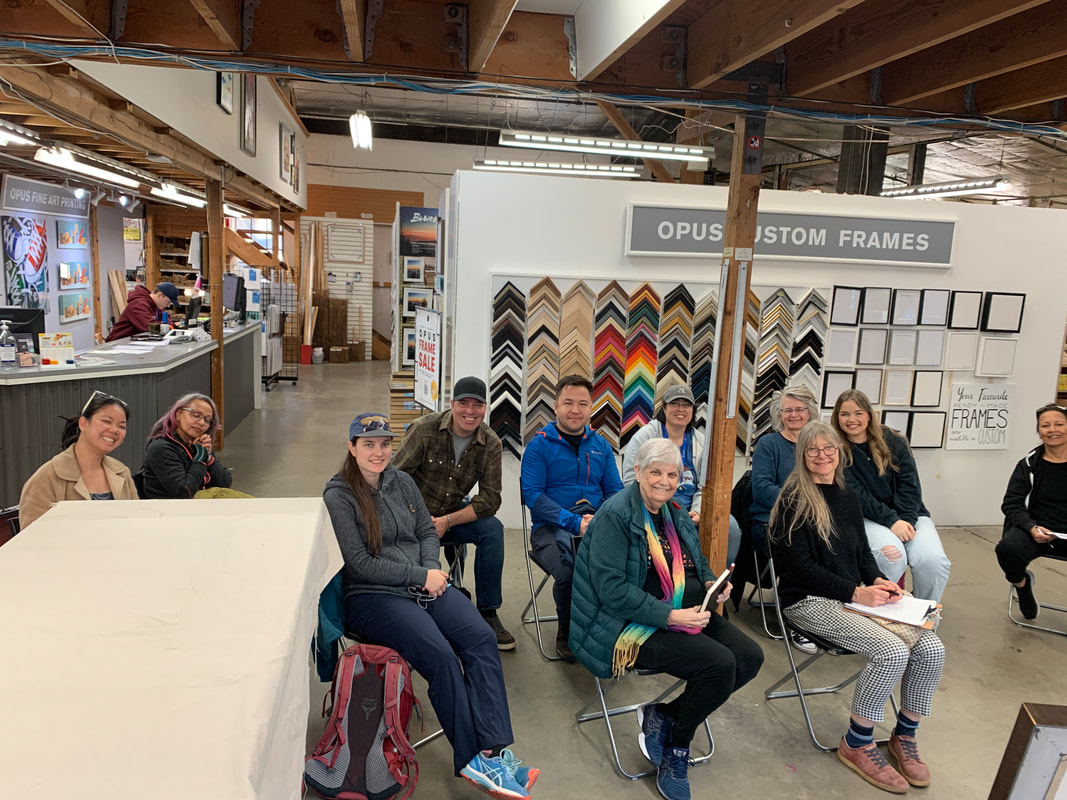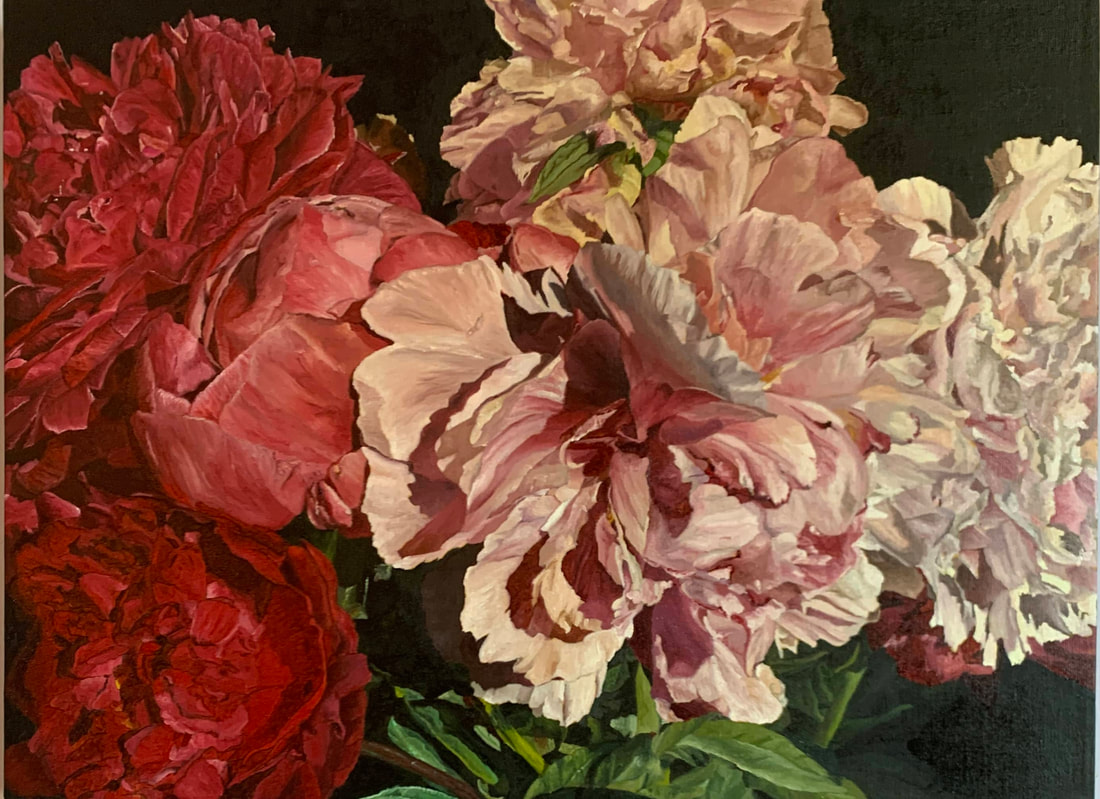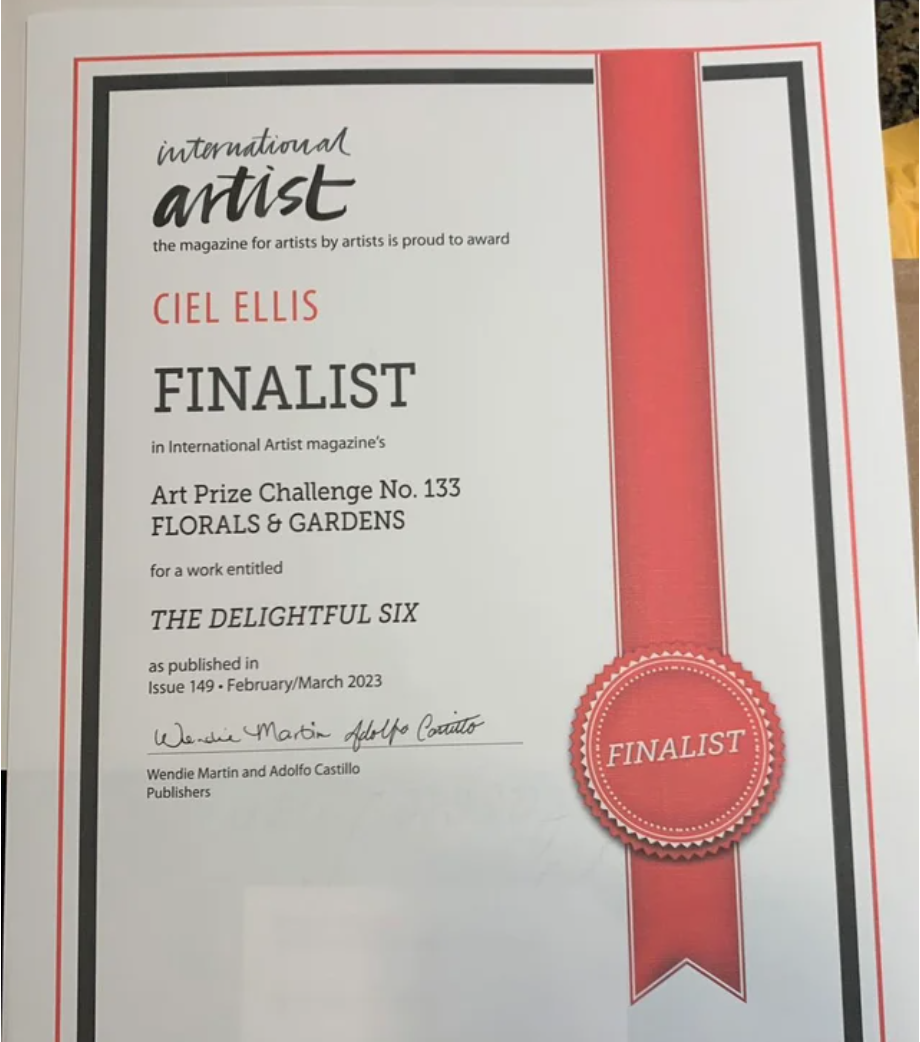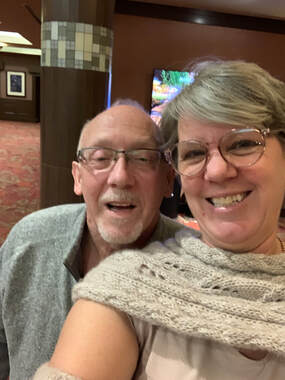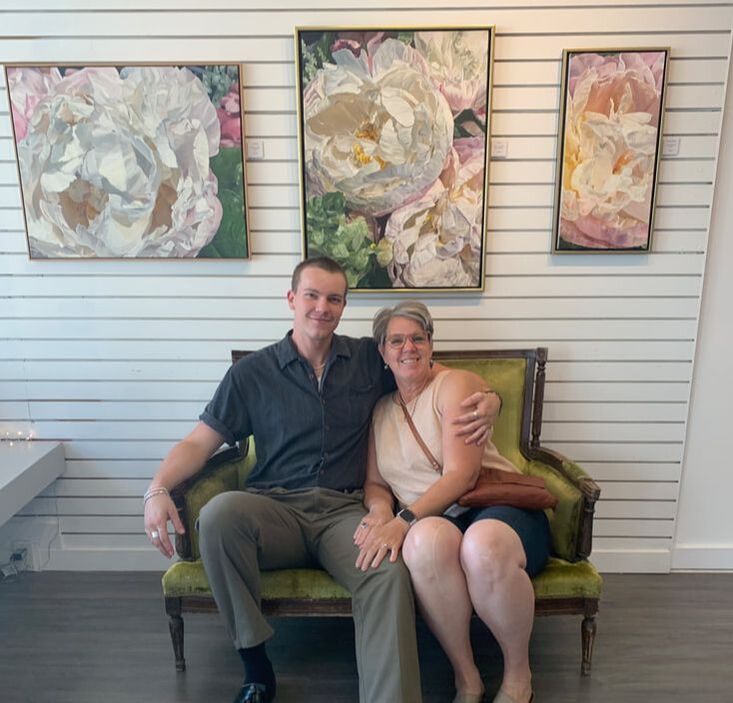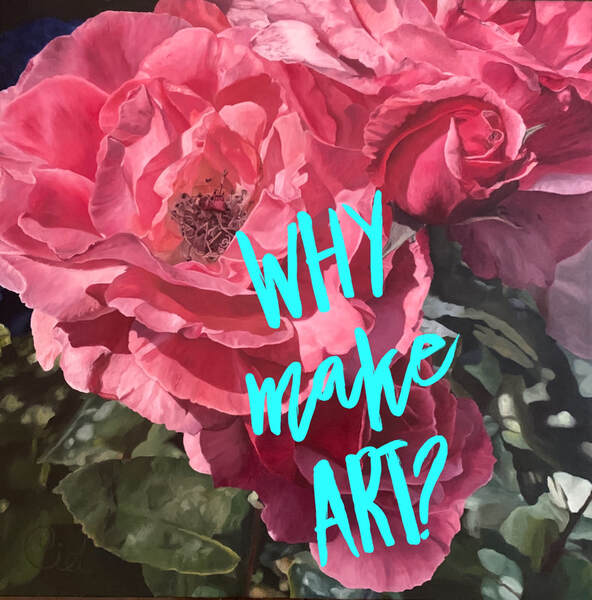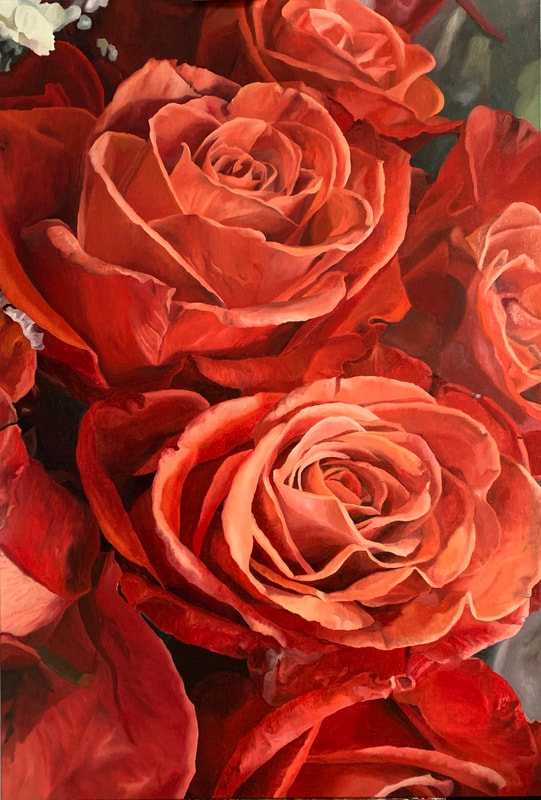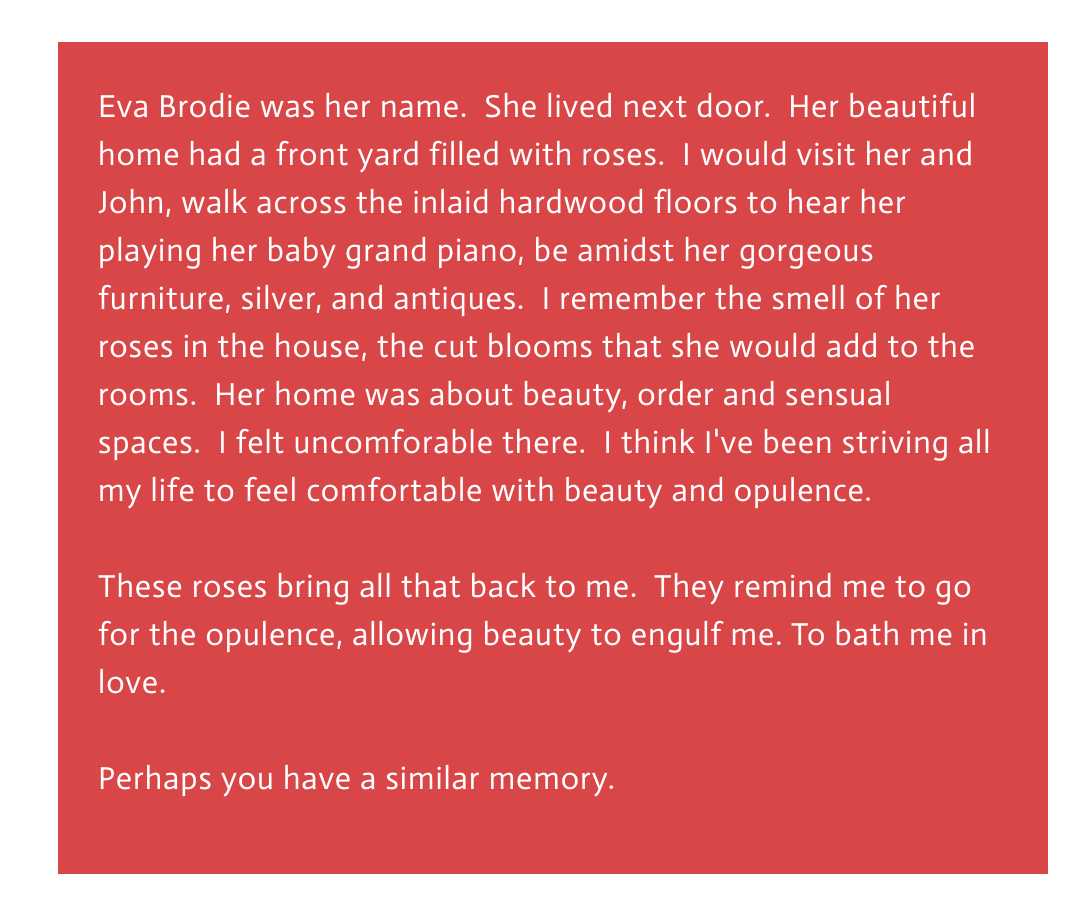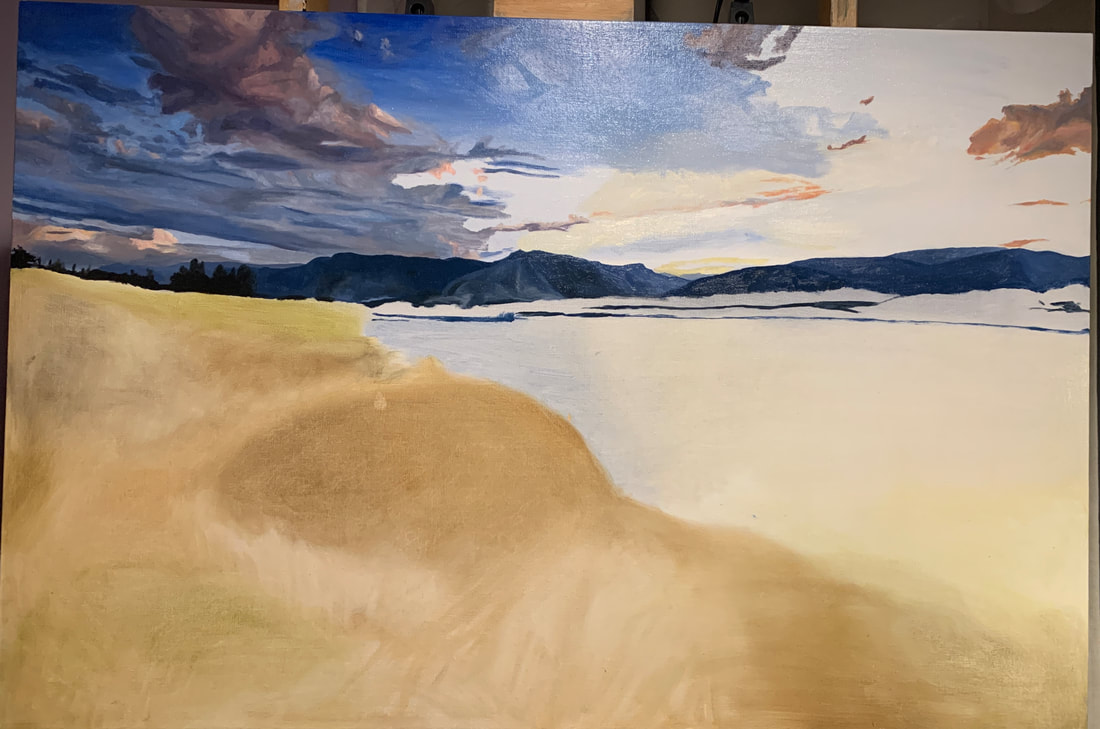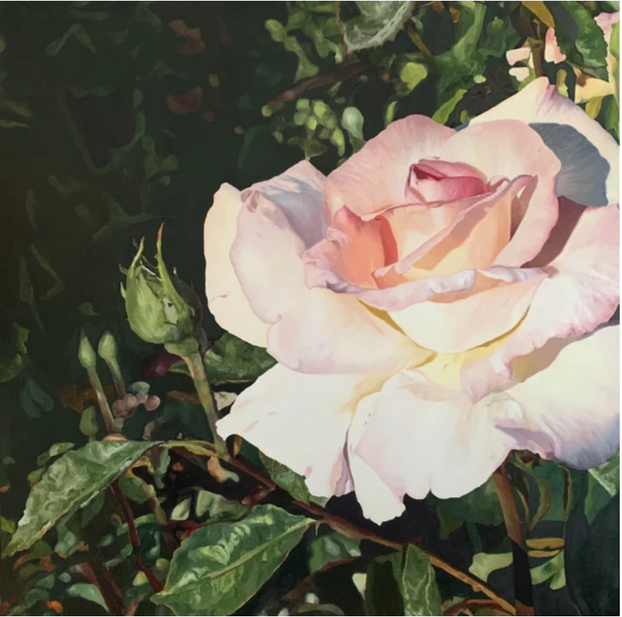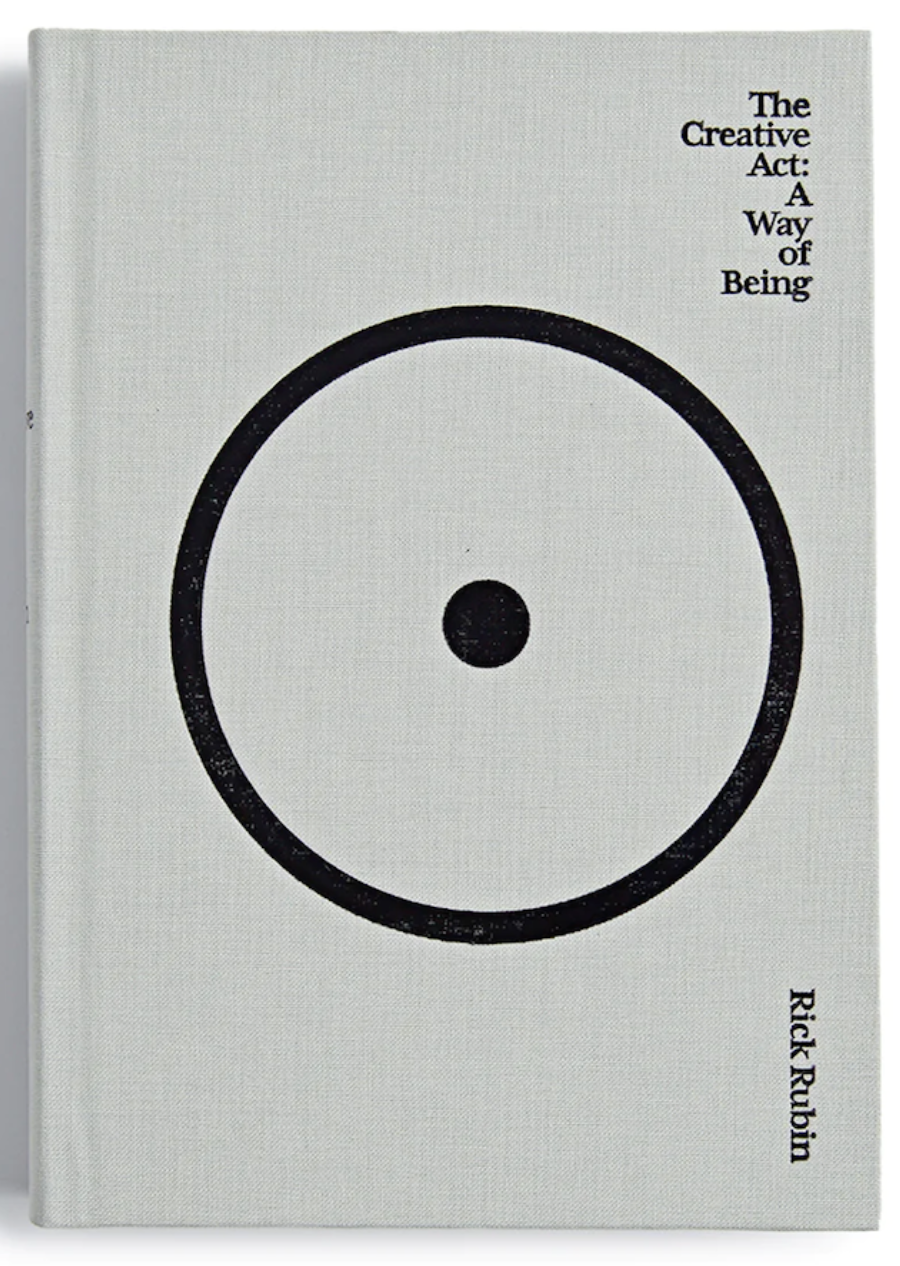Blog
|
This piece... oh my. Let's start with the details. 36x36" oil on canvas, featuring a single pink rose, wrapped in gorgeous green foliage. Your first impression is of a delicate, romantic pink centre with subtle lemony pink outer petals. It captures your attention and draws you to come a little closer. From a physical standpoint you are being invited in to come close, smell the fragrance, feel the sun on your body, smell the damp dirt and touch the gorgeous petals. In other words you are invite to experience this magical moment in nature. A peace, calm and audible sigh come over you. For a brief moment with this rose your nervous system resets. All is well. Whatever is going on, all is well. From a psychological standpoint you are invited in to consider that all the trauma, stress, abuse, loss, fatigue or whatever is occupying your mind is not the only thing that needs your attention. Your beauty, creativity, passion, joy, dreams, desires all require nurturing too. Far too often we ruminate on the things that upset us. Rightfully so, as those things do need to be tended to and sorted within your own mind. However, they can consume decades of our time, while we try to diminishing their effect. Those decades may be better spent choosing other things in addition. Not to negate the difficult feelings, rather to offer some contrast, some reprieve from the unresolved things within us. What if you are invited in to the possibility that you can dream of the things that bring you joy? That you are worthy of feeling relaxed pleasure. What would change for you, if you allowed those opportunities to come into your awareness? Divine goddess guided me to paint this painting for a reason. Perhaps that reason is to remind you of your greatness. The "You are invited in.." collection includes: 1) The original painting. $3497 2) Paper or canvas prints. starting at $306. 3) Poster print starting at $43.75 4) Clutch purse $35.00 5) A gorgeous journal $22.95 6) Notecards starting at $6.00 each. These items are all available on my website. Here is the link to take a look. (Click Here) Whether you decide to purchase something from the collection, or not, please take a moment to consider that you are being invited in to image a life with a bit more lightness, a bit more joy, a bit more fun. It is all there for you. All it takes is a bit of nurturing. Blessings to you on this journey. Love Ciel. This question keeps rolling around in my mind, and I think this might be a great book idea, however, I'm getting ahead of myself. I'm going to start capturing my ideas here and see what happens. If I'm an artist then:
Earning an income from what you create aside, how do I create the work that I imagine? It's so elusive. I have this idea, this imagining, and yet turning that into a tangible thing that even vaguely represents my idea is a huge leap. I have so many decisions to make, from materials to surface, size, and finish etc. These early decisions are a nice distraction and feel so very important, but they mask the actual moment when those decisions have been made and you are sitting in front of the blank, ready, surface. I never looked at this as difficult because my process moves smoothly into the first marks being made. Where the process stalls for me is 10% in, then 20% in, then 35% into the project. Almost every step of the way is an accessing, re-assessing moment. Fear, judgement, self-doubt come along on the journey, always. I read recently that artists who succeed, challenge these fears, those that fail, do not challenge the obstacles. The other issue with creating art is that sometimes the idea or inspiration is actually a feeling, you feel something and want to create something that replicates that feeling. Is the feeling from a piece specific to the artist, or will the audience also feel similar things? Is it necessary that a viewer feel something from your art? Does it help to invoke a sale if the viewer can feel moved by it? It's a risky venture to commit to bringing an idea to life when you have no guarantees that you will actually reach that destination, and more importantly be satisfied with it. Yet, the fact remains that you still feel full of ideas, brimming to release the expression onto some surface. Our backed up artistic ideas can feel somewhat like bloating in the body. Stifling that creative flow can literally look like overeating or drinking to many liquids from the anxiety of holding the creative flow back. When does this change, when you decide to take the risk. When you clear the schedule of distractions and get down to the business of creating your art. Just regular old art, not great art. Very few artistic geniuses have ever existed, yet many regular folk make really great art. Artists are no longer restricted to creating works for the church or wealthy patron, but in the release from traditional relationships surrounding art making, there is so much unsupported freedom that the fear is the artist is not capable of holding themselves up and staying the course so that the art can live. I'm pretty resourceful and self sufficient so I rarely reach out to collaborate or join with other artists. Yet when I meet another artist, of like mind, ready to inquire about all these deep questions, it is magically. Those moments are absolutely priceless. They last from a few minutes to a few hours and man do they fuel the fire. Those are the moments worth creating memories with. Amazing. Being seen and heard for the struggle and the success of the artistic life, is priceless. Let's bring the idea of selling your work back into this musing. The idea that an artist could make a living from the art that they make comes with a whole new set of mental questions. The nuts and bolts are that someone is willing to exchange money for the art that is produced. But in order for the exchange to happen, the buyer needs to feel a connection or desire for that piece of art. The artist knows intimately why they created the art. It's personal. It's a personal reflection on how the artists sees the world. Now is the goal to illuminate that viewpoint so the buyer can join in? Or is it an irrelevant detail? Is the art simply a commodity that is purchased because it's 'neat', or it matches the couch. Who knows why a buyer buys art. There are so many reasons. It could also be with the goal of an investment, the idea that the work will increase in value over time. With all the artistic contributions on social media the arena is filled with art from all over the world, all different genres, several variations on the same genre of art, how does a buyer choose? How is it that one piece of art gets selected to be purchased over the next one? Does it boil down to the "Know, like and trust" idea from other areas of marketing? What if the art doesn't sell? What does that mean? Is this simply another hurdle to get over, to stay the course in the face of a dry patch in sales? Or is it a time to turn away from the pursuit of art and get that 9-5 job, even though you are dreading that prospect, knowing it has been so stifling in the past. I come across a lovely book recently titled "It's not your money." Literally meaning the wealth we have is not actually ours, it belongs to universal spirit, God, Lakshmi (the hindu god for prosperity) or who ever you identify with. That we are just purveyor of that wealth, investing it in our own lives and sharing it abundantly when we are called to.
(As an Amazon Associate I earn from qualifying purchases)
Ultimately, this whole discussion boils down to the individual. If you are an artist, what does that mean to you? I remember a line in Elizabeth Gilbert's Book "Big Magic". What shit sandwich are you willing to eat? The idea is that no career is going to be all roses all the time. Are you willing to put up with the challenges of this particular career you have chosen? It's a great question, and it calls up the quality of stamina, perseverance, and determination. Despite evidence are you willing to continue to show up and do your work? To show up and allow room for these creative idea of yours to bloom into something? Only the individual can decide. There is no outside person that bolster the creative, to hole them up, on an ongoing basis, if they are not willing to hold themselves up.
It comes down to love, self love, self respect and self awareness. This is super important when criticism comes, as it will. I think the criticism is just another form of block coming to test our determination. DO NOT take it personally and DO NOT stop doing what you are doing just because someone objects. They feel compelled to tell you about it, because there is something in them that needs to expressed. It is not about you or your work even though the words they are saying are laced with connections to what you have produced. Keep going, be you, do it your way. If you need to get a job to make ends meet, do it with lightness and grace knowing that this is not your thing, just something that is helping to ease the artwork into the world. Most importantly do not change to impress another person. Rick Rubin in his book "The Creative Act" talks about the art not being for the viewer at all. It can't be. It has to be about the artist and what's good for the artist is ultimately good for the viewer too. Onward..... Create your art. You are an artist if you say you are. Creating art is an unnecessary, necessity. (I read this in a book and can't recall where now.) We might fall into the trap of thinking that the dentist, nurse, accountant, school teacher are more valuable than the artist. Art is what makes everything possible. Art is in our everyday lives. Every beautiful thing has been conjured up by an artistic mind. Please find space to contribute your unique artistic voice to the mix. We need you.
I was a little surprised the other day when I heard that a fellow artist questioned by distinction with the Federation of Canadian Artists simply because I use a projector to aid in transferring my image to canvas. First of all the artist in question holds a much lower distinction, so there may be some insecurity/jealousy on her part. I was shocked to hear her comments. The staff who spoke to her made it clear that my work earned the distinction simply on the merit of the paintings that I produce.
The residue of this conversation has me thinking about a book I read recently that blew my mind. Since about the 15 Century there is evidence that artists were using a lens to assist them in transferring an image to the painting surface. About 1420- suddenly everyone can draw better. Artists such as Caravaggio, da Vinci, Durer, Frans Hals, Ingres, Vermeer, Van Eyke, and Velasques, to name just a few. If the artists themselves were not using a lens directly the changes in the style of art after the use of the lens definitely influenced them, and every artist since. The use of a lens in the transfer of images revolutionized the way art has been made ever since. Have you ever seen early portraits that were done only in profile or straight on? When artists starting doing 3/4 profile portraits, why was that? The use of a lens. How about perspective? Early landscape pieces have a wonky sense of space and distance. They were often quite flat and distorted. When did we start to see more representational distance in landscapes. After the lens was introduced. Now what type of lenses am I talking about?
The book that I mentioned is written by David Hockney. Here is the link to take a closer look. (As an Amazon Associate I earn from qualifying purchases.)
Here is the excerpt from the book: Join one of the most influential artists of our time as he investigates the painting techniques of the Old Masters. Hockney’s extensive research led him to conclude that artists such as Caravaggio, Velázquez, da Vinci, and other hyperrealists actually used optics and lenses to create their masterpieces.In this passionate yet pithy book, Hockney takes readers on a journey of discovery as he builds a case that mirrors and lenses were used by the great masters to create their highly detailed and realistic paintings and drawings. Hundreds of the best-known and best-loved paintings are reproduced alongside his straightforward analysis. Hockney also includes his own photographs and drawings to illustrate techniques used to capture such accurate likenesses. Extracts from historical and modern documents and correspondence with experts from around the world further illuminate this thought-provoking book that will forever change how the world looks at art.
If you are interested in the documentary, you can see it here. BBC Youtube feature.
How this all pertains to me is that I'm a business woman. I have a choice. I could spend two days transferring an image to the canvas or I can use a projector and accomplish the same thing in 45 minutes. It's neither efficient or cost effective to opt for slower techniques when there is an alternative. The fact remains, either way the painting does not paint itself. It is my mark in the line drawing and my mark in the painted representation. It is all me regardless of how the image was transferred to the painted surface. If we naively think that there is some elite place of prestige because we don't use any technology to produce our paintings then it also means you better be mixing you paint by hand, grinding your own pigments and using egg tempera as a binder because the advent of the metal tubes of paint we buy are a result of technology. Did the ancients use tubes of paint once they were available? You bet they did. We would not have the Impressionist period of art had it not been for portable tubes of paint. Technology is a part of our life as it was for the ancients. Be clear on the point of making art the way that I do. Honestly, there are so many options to choose from between medium, subject, method etc. I think I have most of the process decisions all sorted now. At the core of all the choices is my purpose to create art in the first place. There are a few things I'm clear on: 1) I want to immerse myself in my process so that I can feel the rhythms of nature, 2) the colours that I work with have me feel amazing, 3) my perspective/viewpoint is unique and I think impactful, 4) I want to have an impact, 5) I want people to be attracted to my 'brand' of art because I create something unique. A very good question comes up from this. Why paint at all, why not take a photo and leave it to that? The painting process, mixing paint and putting a mark on the canvas is my unique 'voice' being spoken through the decisions that I make. What I create comes entirely from my intuition and skills. I feel like that is important. It's my imprint on this time in history. If your painting is about colour, then why not abstraction, playing with just colours? Representational art is something I enjoy, the challenge of it. Creating the feel of the real thing is an important part for me. I said to my husband this morning, when I showed him a proposed upcoming painting, that it feels like ballet. The movement down the jagged edge of a leaf, the rhythm of the spacing and shaping is magical. I want to experience those rhythms coming from by brush. I want to understand how the colour changes across the leaf. How the different values and hues end up representing the real leaf, as I understand it. That's the key, as I understand it. My understanding. My mark making. My vision. In this regard making art feels self-centered and self-serving. Which it really is. As Rick Rubin says what's good for the artist is ultimately good for the viewer. He states that art making can never be about the viewer, ever. In my mind, pleasing a viewer will never be sustainable, because viewers have differing ideas of what they like. It would be like constantly chasing your tail. You think you are making what the audience will like/buy, but you could be totally wrong. It seems I ask myself, fairly frequently, what's the point of all this? Each time I come to a greater understand and conviction about the contribution that I have to make to my community. What I've done in the past couple of years is look specifically where my art can make a difference. In 2023, I donated a painting to the rebuilding of Lahaina. I cried when I realized my beautiful painting was going to a great new collector, but also helping those who lost everything in the devastating fire of 2023. This year, I will be producing and donating all the profits of a 36 x 36" painting for Malawi Africa. I'm going to fund a water well. I guess there are (5) communities that are in dire need of water wells. It feels great already to be putting this together for people in need. In 2023, I also sent out close to 180 mini prints of one of my artworks. I do this each year. It's a special gift that I send to my email recipients. The kind words and appreciation I receive from this little gift is quite amazing. It feels good. Art makes us feel good. I feel good creating it. Collectors feel good receiving it. It's a win, win. If you would like to be included in this free gift, simply join my email list and leave me your full mailing address. You can do that here. Next time you purchase an original or reproduction of an artists work, just know that you are helping to make their career and dreams possible. Your support is deeply appreciate in ways that are not easily measured. When an artist is support they are able to continue to produce and share their work. I for one, appreciate all the support that I receive. It is such a gift. Namaste.
I read a lot. I love learning especially when I find inspiration and guidance from authors who have experienced similar inquiries. I crave all kinds of different books from money mindset, to habits , to truth telling about what it really takes to have this art career. There have been some wonderful leaders share their wisdom and I feel blessed to be able to learn from them. This short list of titles are the ones that I have in my permanent collection and that I have read multiple times. No frivolous recommendations here, these are my go-to's.
Let me give you a tour of the books that I find particularly helpful. Just a note, if you click the title of the books, it is a link to the listing on Amazon. If you decide to purchase using that link I earn a small remuneration. “As an Amazon Associate I earn from qualifying purchases.”
Boy this is a book that a lot of people are talking about. Do a Youtube search and you will find several interviews with Rick. If you have not heard of Rick Rubin he is a world renowned music producer. He has worked with the Red Hot Chili Peppers, Johnny Cash, Adele etc. But you won't find him leading with all his associations. He is a humble, spiritual guy. He would like to produce great music, something that has you say "Wow, I've never heard that before." What's interesting about Rick is that he has worked with many different personalities gleaning all kinds of wisdom about the process of being an artist. This book is an easy read with small vignettes of wisdom and some really great quotes. I'm really enjoying it.
Twyla Tharp is an American dancer, choreographer, and author who lives and works in New York City. You might wonder what a dancer can teach an artist. The premise of her wisdom is that art is first created when a habit that supports the art creation is put into place. She talks about her routine of getting out of bed, hailing and cab and heading downtown first thing. Her creative expression starts when she climbs out of bed. Setting yourself up with the habits that foster the creative practice makes being creative so much easier. Again, it's a lovely read. Her style is easy to follow and makes a lot of sense.
Lynn Grabhorn breaks down how our thoughts and feelings affect what we do with our lives. I believe that this life of ours is all made up by the experiences and beliefs that we choose to nurture. Lynn encourages us to take a close look at the thoughts and ideas that we are allowing to occupy our days. Some of them may not be that helpful. So how do we change the thoughts and empower ourselves to capture something else? Lynn goes into that with stories and ideas from her own life. Great read. I have to pick it up again myself. I've read it several times and always get such benefit from them.
Oh Maria. Such a lovely woman. You can find here video teaching online with a quick search. She has been a business consultant to creative entrepreneurs since 2009. What I especially enjoy about Maria is her innovative way of approaching business. Just as an example her husband Drew Brophy is a surfboard painting artist. They wanted to be a part of the big surfing exhibition where all the major brands and fans of the surf culture gather. However, they didn't want to purchase a booth themselves. Maria thought to approach one of the surfboard brands and offer that Drew do a painting onsight during the event. They were thrilled. This is quite an entertaining draw for the guests to the show. Seeing an artist in action... very cool and they had one of their boards painted by Drew. In addition, when you enter the exhibition there was a large wall of the building that was blank. Maria approached the organizers and asked what they planned to do with the wall. They didn't have any plans. She suggested that they bring a number of boards down and decorate that space. The organizers loved the idea. This was a huge win. Drew's boards were the first thing people saw when they arrived and he was painting 'live' during the event. Great promotion and they didn't have to pay for any of that exposure. Innovation in action. This book is filled with idea that artists can implement in their careers.
Oh Elizabeth Gilbert. I love her writing. Eat, Pray, Love is one of my favourite books. However, Big Magic - I think I've read it 5 times so far - is a must have in my library. One of the quotes that stands out from Jack Gilbert, not related, is "Do you have the courage to reveal the gifts you have inside." This quote has stuck with me. The other idea is "Which shit sandwich are you willing to eat?" Not everything in your chosen field is going come up roses. So what you are willing to put up with in order to have the career/art expression that you want? It's a great question. When things get hard are you going to be able to realize the shit sandwich for what it is?
Jen is quoted as saying "If my broke ass can get rich, so can you." Money is such a thing in our lives. We either love it or hate it, it seems. If money is not loving you, what can you do to change it? From Jen's start of living in converted garage with her broken down car, collecting bottles and wondering where the next meal was going to come from, to her revolutionizing the way she thought about what she had to offer. It's pretty inspiring. I have really enjoyed getting to know her work. I think you might enjoy it too.
Observations on the perils and rewards of artmaking. Now isn't that an awesome title. This little book is a breath of fresh air. A no nonsense read that tells it like it is. For example, the authors tell us to get over the idea that we need to be a genius to make art. Geniuses are rare, just go make art. Great art, ordinary art, is made everyday.
This book explores not only how art gets made but also how often it doesn't get make. The difficulties that artists come up against and how often they stop the art process because of the challenges. This book is written by artists for artists. What is it really like to make art? This is a go to book for me. An easy read and one that sets me up on my two feet again when I run into the challenges of making my art.
"Establish a daily practice, infuse your world with meaning, and succeed in work + Life."
Chase Jarvis is an interesting guy. He was on his way to Grad School, going after a career he came to realize is not what he really wanted. He left Grad School, grabbed his camera and set out to attend every extreme sports event he could afford to get to in order to take the action photos that he was drawn to take. He was largely self taught, and wanted to make a career as a professional photographer. This refreshing book that he has written outlines the journey he took to his career. It's quite inspiring and thought provoking. Check it out. I hope these suggestions help you in your artmaking. Do you have a book that you are reading that you want to recommend? Let me know. I love learning and I'd love to hear what you are reading. Leave me a comment below. It's January 1st, the perfect time to reflect on the successes from last year. Here's the run down. 1) I painted for (7) shows last year, getting in to 6 of them.
2) I took on a month long watercolour painting project. I set out to try plein air painting with this project and soon realized that the cold, windy weather made it so uncomfortable that I would jot down the start of an idea, take a photo and finish the piece back in the studio. It was an amazing project. I produced (33) small pieces and sold all but three of them. 3) Lahaina, a beautiful seaside community on Maui was completely destroyed by fire. The Oil Painters of America, which I'm a member of, partnered with several other arts organizations to put together a fundraiser. I decided to contribute a piece to the cause. It felt amazing to be a part of it. "Peach Hibiscus" is the piece that I donated. 4) In total last year, I completed 10 paintings which may not seem like that many, by quantity, however, they totalled 7100 square inches. That's 350 hours of painting, and almost 100 square inches more than last year. Whew. 5) Commission were a big part of my year. From Ontario, to Idaho, to local clients It was fun putting these projects together for them. 6) I was asked to speak and present with Opus Langley & Granville Island as well as present at the South Surrey White Rock Art Society. Great to share knowledge with other artists. 7) One of my paintings, "The Delightful 6" was accepted, by jury review, into The International Artists Magazine. It's a publication out of Scottsdale Arizona that reaches over 100,000 reads around the world. Wow. It was awarded a finalist in the Florals and Gardens category and printed in the Feb/Mar edition. Very cool. 8) In my personal life, my husband and I celebrated our twelve anniversary. It's wonderful to have a partner to walk this life journey with me. Very grateful for all the support from my family. 2023 was amazing on so many levels and it was also one of the most challenging. The deeper I get into my art career the more I find myself refining what it is I really want to do with my art. I am embarking on another philanthropic project as well as planning to create a number of gorgeous paintings for shows/exhibitions and special collections. I have some big plans for next year. Stay tuned. All the best for a wonderful 2024. For centuries artists have gone to great lengths to create their art.... but why? Why go through all the hardships and challenges to create something?
Art began as a way to document the lives and activities of early people. It was a way to leave a mark for future peoples to understand and learn from. Which evolved into intentionally telling stories with the use of images. The early church ministered to largely illiterate people and the way they communicated their teachings was by way of painting the story through images. Those images were often used to influence the viewer, perhaps frightening them to behave a certain way, to donate gifts to the church etc. The creation of art was then adopted by patrons, wealthy landowners, nobility, and clergy, to present themselves in the best light, to show their place in society, their stature, their wealth. When patronage died out artists were forced to find their own patrons in the form of gallerists or private collectors who would fund the production of their work. This is largely the environment that we still find ourselves in. Irregardless of who commissioned the artwork whether patron or artist driven, art is a way of saying something that words cannot convey. To invoke emotions, to stir ideas, to create a mood or reflection about something meaningful, to make a political statement that goes otherwise unheard. With the advancement of cell phone camera technology, why not just take a picture, manipulate it with a filter and use AI to enhance the image and call it a day? Why even bother creating a handmade piece of art? The answer is in the handmade. Artists make a mark that conveys emotion and intent by the very materials they choose and the way they apply those marks. I mean no discredit to photographers - their form of art is simply a different medium. As a fine-art oil painter, I have something to say with my art. With my HEart. The handmade, personal process of creating my art, navigating the myriad decisions that need to be made, means I get to put my unique stamp out into the world. Which is a bit self serving and egotistical because I have the belief that what I have to say is important. My work has an impact, a positive, beautiful impact. Never before in my life have I felt so on purpose with my creativity. I know this must be true for the artists that have gone before me because they created their art in often dire conditions. Why the tenacity? Why continue when the challenges are many? Art matters. "Art fulfills something in us that we lack" - Richard Serra. France, the most visited country with Italy a close second, are so sought after simply because of their history, art and beauty. The value of their art is immeasurable. Art is unbelievably worth it - Jordan Peterson. Katerina Gregos said "Art is the unnecessary, necessity. Without art the banality of reality would be intolerable." For me personally, I understand that creating art is my purpose. This is what I am gifted to do and I intend to do it to the best of my ability. I have something to say with my art. With the current state of the battles going on in our world today, I know that our nervous systems are on overload. If I can bring some peace, a moment of beauty to restore a sense of calm, I'm all for that. As a certified life coach, one of my past clients faced a two hour commute from her home to get to any park or natural spaces and once there, she had to share it with thousands of people. This is a type of poverty that seems intolerable. The disconnection with mother nature. We need art. We need beauty. We need a connection to mother nature. If you are feeling disconnected, over stimulated, and need a bit of peace, it is my hope that one of my paintings would help sort that out for you. You can see my art at www.cielellis.com I know, love is so cliché. We don't really want to talk about it because it's awkward. Love means different things to different people. And there are so many nuances within the concept of love.
So let me see if I can capture what I'm meaning. When I was young, there was a lot of trauma in my life. My nervous system had a hard time because there was always a new challenge. The result was that I shut down a lot of my emotions, withdrew, had few friends, and felt quite lonely. The longing to feel 'well' has been a driver for in many years of counselling and my 30 years of journaling. Through my healing journey I have been seeking a sense of myself where I'm able to feel all the 'feels' without being overwhelmed. My art practice has been the best self help that I have ever done. When I'm at the canvas it's all me. My desire to create the idea meets my skills, and my pigments, while my intuition/muse meets me and together we explore how to bring the vision to life. During the painting process I have to trust myself. I have to listen closely to what the painting wants next from me, and I have to listen to the fatigue in my mind and body if I sit for too long. It is such a dance. I'm so immersed in the painting that I often find myself crying as I complete my painting. It is such a wonderful feeling. Then I sit back and revel in what I've created. I often wonder "I made that?" It's a fascinating process for me. This is the love, connection, acceptance and relaxation that I crave. It's where I feel well. The other remarkable aspect is that what I create is a point of connection for my collectors/viewers. My challenge is to convey the love I felt making the painting in such a way that viewers can connect to it. I'm working on that. What makes me absolutely overjoyed is when a collector says they would like to own a piece of my work. It is the full circle moment when the love I felt with the initial idea lands with the right person to receive it. It feels like a give and take exchange of positivity and LOVE. It's my goal and hope that the paintings currently in inventory and the ones that I have planned for the coming years in my career will continue to connect with people in a meaningful way. That my art will make a difference in the world. That I will be able to donate paintings for a philanthropic vision, doing good for others beyond a single collector. Onward we go. Bring on 2024. I'm ready to celebrate over the holidays and meet the new year with new vitality for this amazing career. Thanks for coming along on the journey with me. I had a 'wait a minute' moment the other day just after I posted this lovely little story. This little story reveals so much about my idealist ways. True fact, John and Eva Brodie were our neighbours. I would go visit them. Their home, the bones of it anyway were beautiful. Inlaid hardwood floors in all the main rooms, lino in the kitchen, bevelled glass french doors, the works. Untrue fact, the spaces were lovely. Here is where the 'wait a minute' pause comes in. As I walked away from posting this little story, I hear myself say, "it wasn't like that at all." No disrespect to John and Eva, but the place was a cluttered mess. Papers stacked upon stacks and that smell that you can't quite pinpoint. A touch of dust, age, and forgotten corners. Nothing foul, just age. True fact, Eva did have a gorgeous garden. Is there where my love of flowers came from? Who knows. I don't really think so. I do remember her having lovely bouquet's inside that perfumed the house. Untrue fact, she had a baby grand piano. I think she had an upright. So why have the details gotten all scrambled in my own mind? Because I'm an idealist. I likely walked into her home, saw the clutter, and my imagination took over and imaged the spaces all cleaned up and beautified. Quick fact about me, I see the beauty in even the most mundane things. Certainly in my paintings, I'm able to focus on the beauty of an everyday object. See they come alive for me. Something about the shapes, the colours that are cast as the sun moves across the surface. I find it mesmerizing. My husband and I were talking about my work versus say landscape scenes. Where I am focused in a localized colour, dancing in the subtle nuances of a closely cropped image, a landscape is filled with so many textures, shapes, lighting effects - I think I find it a bit overwhelming. The flower paintings allow me to at peace with the image and relax into the variations that create the shapes. It's fascinating to me. All this being said, I'm currently working on a landscape and really enjoying it. There are a few differences with this piece. 1) I'm not working from a detailed line drawing, which I do when I paint the complicated florals. I had a detailed line drawing, but it vanished when I applied the first wash of oil paint. Darn it. 2) Without a line drawing I'm really relying on the shapes, colours and placement of the pigment. It feels easier somehow. I feel a learning lesson in the process of all this. Pretty excited about it. Here it is. Only the top left sky has been properly painted in.
Back to my idealist ideas. Ideally I can capture the beauty of this place that has special significance for us. The ramblings of an artist finding her authenticity in the idealistic memories. This has been a big year. I'm arriving at the end of this year, 2023, a bit creatively tired. This past year I set the goal to paint for (7) different shows including a solo show at a local gallery. At the beginning of the year this felt daunting and yet with my dedication I was able to meet all the deadlines. I was accepted into 5 of the 7 shows that I submitted to including an International exhibition in Toronto. With the help of my collectors I hopped on a plane to attend the gala in person, thanks also to @Andrea J.Lee who graciously taxied me around, took the videos and entertained me for the rest of the event. So grateful!!! The wins include completing probably my best work, so far. The paintings are amazing. The challenge that I'm now facing is that the expectations from these shows have fallen way short. I expected there would be sales to go along with the added exposure. That has not been the case. I also know that art sales have been slow for every artist that I've spoken to regardless of price, genre, sales channel or experience. It's not just me. As a result, I've been doing some personal work to try to sort myself. One of the books/interviews that I keep going back to are those from Rick Rubin. Now if you are not familiar with Rick he is multi-award winning music producer who has been in the industry for 40 years. While he has decades of experience his ego does not come charging into the room to tell you all about his collaborations. Rick is an intuitive, meditative man, with some really wonderful insights.
This, I think, is where I've gone astray. I think I was focused on the outcome more than on the love of creating what I was truly inspired by. Which isn't entirely a true statement because the pieces I've created are absolutely loves to me, but the context of creating them for show/accolades and the expectations of sales has tainted the experience for me. I think this creative act is sacred. It's between me and God. It's the precious gift I can give of my heart and spirit. It's a piece of me that I make myself vulnerable enough to create and then share. I want to add that Rick's words about art being like a diary entry and really not about anyone else has been a valuable concept. In the past few weeks I have had another artist bring some pretty harsh comments to me. Her reflections on the quality of my work and how I've missed the mark in the perfection of my creations. Yikes. The work comes through me, once I share it, it's available for interpretation and critique. I know that. What I find challenging is to stay true to my creative soul in the face of these comments. They still shake me, which is likely the lesson here - growing my own resolve so the comments do not shake me. For Christmas my son asked that I make him a painting. I've chosen a landscape with a scene of Okanagan Lake at sunset. It is going to be amazing. I am not known for landscape work as I haven't focused there in my career. However, I'm enjoying myself. What I've learned from the floral paintings is helping me so much in this landscape. I have about 8 days of work left on this piece. The top quarter is all that has been properly painted in. (If you were wondering why the foreground looks all fuzzy). In the act of creating art, I meet myself at the canvas each and every time. I meet my doubt, my worry, my insecurities as well as my hopes, joy, and excitement. Being creative is a full bodied, full emotioned experience. I want to pay tribute to a fellow artist whom we lost. It is such a tragedy. He finally had arranged his life in such a way to be a creative full time. I don't know what happened, what challenges he was up against, however, he stepped off this life journey and decided not to continue. He was so talented and had so much he wanted to accomplish. I'm grieving for him. I never met him. I knew of him from social media and a mutual friend. I'm grieving the potential that has now been lost. I'm also grieving for the genocide that is currently going on in Gaza. The destruction of lives is unconscionable. Why is there such brutality in the world? Why are people still starving in Africa? Why do our first nations not have clean drinking water? So many questions I can't answer. All I can do is my best with this life I have been given to live and as far as I can tell I'm meant to create beautiful art for the sake of bringing beauty and love into the consciousness of those who interact with it. Next year I'm planning to product and donate a painting/products to fund the installation of a water well in Malawi Africa. Stay tuned. The painting will be revealed in early May 2024. Thanks for coming along on this journey with me. Happy Holidays. I wish you all the best as we close out this year. |
Loading... Archives
April 2024
|
|
Join my VIP email list. First access to new work. Relevant content only, spam free. |
